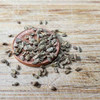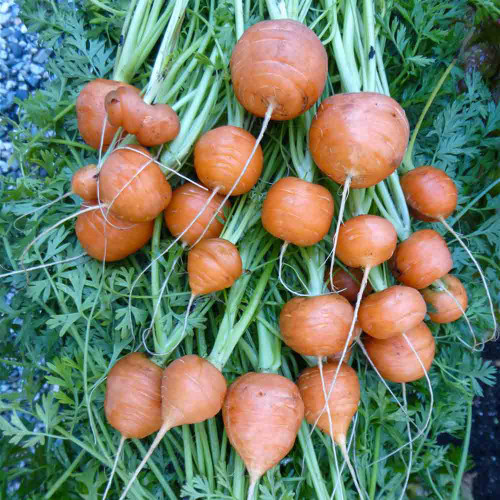Red Cored Chantenay Carrot Seeds - (Daucus carota v. sativus)
- SKU:
- V1026
- Seed Count:
- Approx 500 seeds per pack
- Days to Maturity:
- 60-75 days
- Shape:
- Stubby
- Days to Germination:
- 6-21 days @ 50-75F
- Plant Spacing:
- 1-2"
- Light Preference:
- Full sun
- Soil Requirements:
- Light, sandy or humus, well drained soil
- Status:
- Heirloom, Non-Hybrid, Non-GMO seeds
Description
Red Cored Chantenay Carrot - Great Carrot Taste
Red Cored Chantenay carrots are crisp, tender, sweet, and crunchy large-bodied roots with deep red-orange color from the skin to the very center. This fine-grained smooth refined carrot was introduced by the French seed company Vilmorin-Andrieux in the late 1800s and quickly became a beloved American heirloom about 1929.
Their dependable high yields, coupled with their signature sweet crunch quickly made them a benchmark for all carrots to be measured against. In fact, Chantenay carrots are still commercially grown for the canned and processed carrot markets.
C. C. Morse described them in their 1931 seed catalog:"The first time you pull this new carrot you will want to eat it then and there. The deep orange-red color and smooth symmetrical shape are combined with just the right size to make it irresistibly appetizing. Its beauty is not merely skin deep; it goes clear through to the very center and the interior is even more tempting than the outside. The yellow ring which is usually found around the core of carrots has been bred out of Red Cored Chantenay and in the breeding a sweeter, richer flavor has been acquired. This flavor alone is enough to establish its superiority and when combined with the crisp, tender quality and deep color of the flesh a new treat is furnished for those who appreciate the healthful and high nutriment value of carrots. On the inside back cover will be found an unretouched photograph of this and other carrots in natural colors."
Sweetens in storage, making it the perfect early Spring or Fall and Winter garden candidate. For table use, canning, juicing, freezing or storage. Heavy producer, even in heavier soils.
History
Carrots originated in Europe and Central Asia. The first cultivated variety had branching purple roots and is believed to have been developed in Afghanistan. It migrated to the Mediterranean in the 14th century and then northwards. The orange varieties were developed in the Netherlands in the 17th century.
Uses
Coarsely or finely grated carrots are eaten raw as a salad. They are one of the most widely used vegetables they are cut, sliced, diced, cooked, steamed or juiced. Carrots are included in soups and stews and used in sauces and stocks.
Harvest Tip
Give carrots a good twist when you pull them up so that the leaves do not break off in your hand, but once they are up, cut off the leaves right away. Carrot tops may look pretty, but they keep growing and draw moisture and nourishment out of the roots, leaving them limp, wrinkled and tasteless.
Learn More
- Grow Delicious Carrots from Seed to Harvest
- Braised and Marinated Carrot Recipes
- Cool Season Vegetables to Love
From the soil to the seed to the food you eat - we'll help you grow your best garden!













